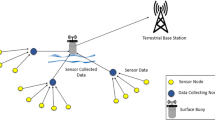Abstract
Distribution of nodes in different depths leads unbalanced energy consumption in underwater wireless sensor networks. This issue is one of the most important challenges in routing protocols based on depth because nodes with larger depth rely on smaller depth nodes to send their data to the sink through multi-hop communications. This situation applies high load on nodes with small depth as they die faster than other nodes. Besides, low bandwidth and speed of acoustic channels in the underwater environment result in increase of the probability of collision especially when several nodes send their data simultaneously and increase of delay in sending and collecting data. The aim of the proposed protocol which is called energy-efficient data gathering scheme (EEDG) is to relatively fix the aforementioned problems in three steps. Firstly, the balance of energy consumption is achieved by grouping nodes into smaller sets that are managed by temporary forwarder nodes. Forwarder nodes are responsible for gathering data from their subset nodes in one-hop communication in each round. Secondly, collision rates and packet loss are improved using the proposed MAC protocol by which ordinary nodes send their data to their forwarder nodes only at dedicated time slots. Finally, delay in data collection process from the whole network is decreased using the proposed graph structure, that is, forwarder nodes are met by the mobile sink according to the specified degree for them in the graph. Simulation results using NS2 show efficiency of the EEDG in terms of energy consumption, end-to-end delay, and throughput.










Similar content being viewed by others
References
Gkikopouli A, Nikolakopoulos G, Manesis S (2012) A survey on underwater wireless sensor networks and applications. In: 20th Mediterranean conference on control and automation (MED), Barcelona
Brady D, Preisig JC (1998) Underwater acoustic communications. Wirel Commun Signal Process Perspect 8:330–379
Sandeep DN, Kumar V (2017) Review on clustering, coverage and connectivity in underwater wireless sensor networks: a communication techniques perspective. IEEE Access 5:11176–11199
Yan H, Shi ZJ, Cui JH (2018) DBR: depth-based routing for underwater sensor networks. In: International conference on research in networking
Wahid A, Kim D (2012) An energy efficient localization-free routing protocol for underwater wireless sensor networks. Int J Distrib Sensor Netw 8(4):307246
Zhu F, Wei J (2018) An energy efficient routing protocol based on layers and unequal clusters in underwater wireless sensor networks. J Sensors. https://doi.org/10.1155/2018/5835730
Majid A, Azam I, Waheed A, Zain-ul-Abidin M, Hafeez T, Khan ZA, Qasim U, Javaid N (2016) An energy efficient and balanced energy consumption cluster based routing protocol for underwater wireless sensor networks. In: IEEE 30th international conference on advanced information networking and applications, Crans-Montana, Switzerland
Abbasi JS, Javaid N, Gull S, Islam S, Imran M, Hassan N, Nasr K (2017) Balanced energy efficient rectangular routing protocol for underwater wireless sensor networks. In: Wireless communications and mobile computing conference (IWCMC), Valencia, Spain.
Hameed AR, Javaid N, Islam SU, Ahmed G, Qasim U, Khan ZA (2016) BEEC: balanced energy efficient circular routing protocol for underwater wireless sensor networks. In: International conference on intelligent networking and collaborative systems, Ostrawva, Czech Republic.
Khan AH, Jafri MR, Javaid N, Khan ZA, Qasim U, Imran M (2015) DSM: dynamic sink mobility equipped DBR for underwater WSNs. Proc Comput Sci 52:560–567
Kartha JJ, Jacob L (2017) Network lifetime-aware data collection in Underwater Sensor Networks for delay-tolerant applications. Sādhanā 42(10):1645–1664
Khan MTR, Ahmed SH, Kim D (2018) AUV-assisted energy-efficient clustering in underwater wireless sensor networks. In: IEEE global communications conference (GLOBECOM)
Ghoreyshi SM, Shahrabi A, Boutaleb T (2018) An efficient AUV-aided data collection in underwater sensor networks. In: IEEE 32nd international conference on advanced information networking and applications
Chen Y-S, Lin Y-W (2013) Mobicast routing protocol for underwater sensor networks. IEEE Sensors 13(2):737–749
Gomathi RM, Manickam JML, Madhukumar T (2015) Energy preserved mobicast routing prorocol with static node for underwater acoustic sensor network. In: International conference on innovation information in computing technologies
Han G, Long X, Zhu C, Guizani M, Bi Y, Zhang W (2019) An AUV location prediction-based data collection scheme for underwater wireless sensor networks. IEEE Trans Veh Technol 68:6037
Radhakrishnan A (2017) Robust energy-efficient adaptive routing (REAR) protocol for underwater sensor networks. In: International conference on circuits power and computing technologies [ICCPCT]
Huang CJ, Wang YW, Liao HH, Lin CF, Hu KW, Chang TY (2011) A power-efficient routing protocol for underwater wireless sensor networks. Appl Soft Comput 11(2):2348–2355
Kularial Y, Kohli S and Bhattacharya P (2016) Analyzing propagation delay, transmission loss and signal to noise ratio in acoustic channel for underwater wireless sensor networks. In: 1st IEEE international conference on power electronics, intelligent control and energy systems (ICPEICES)
Guo P, Jiang T, Zhu G, Chen HH (2008) Utilizing acoustic propagation delay to design MAC protocols for underwater wireless sensor networks. Wirel Commun Mobile Comput 8(8):1035–1044
The Network Simulator. https://www.isi.edu/nsnam/ns/.
Author information
Authors and Affiliations
Corresponding author
Rights and permissions
About this article
Cite this article
Banaeizadeh, F., Toroghi Haghighat, A. An energy-efficient data gathering scheme in underwater wireless sensor networks using a mobile sink. Int. j. inf. tecnol. 12, 513–522 (2020). https://doi.org/10.1007/s41870-020-00445-5
Received:
Accepted:
Published:
Issue Date:
DOI: https://doi.org/10.1007/s41870-020-00445-5




